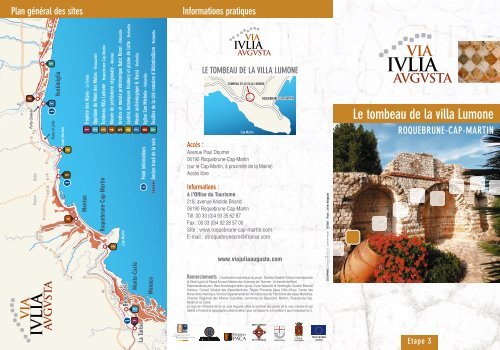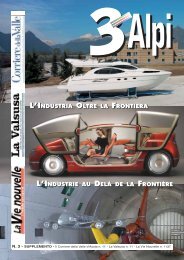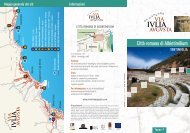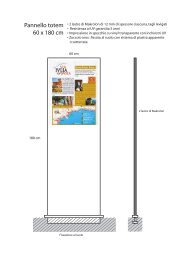Le tombeau de la "villa Lumone" - Alcotra
Le tombeau de la "villa Lumone" - Alcotra
Le tombeau de la "villa Lumone" - Alcotra
You also want an ePaper? Increase the reach of your titles
YUMPU automatically turns print PDFs into web optimized ePapers that Google loves.
P<strong>la</strong>n général <strong>de</strong>s sites<br />
1 Trofeo d'Augusto - La Turbie<br />
2 Il Mont <strong>de</strong>s Mules - Beausoleil<br />
3 Il Mausoleo di Lumone - Roquebrune-Cap-Martin<br />
4 Museo di Preistoria Regionale - Mentone<br />
Porta Canarda 8<br />
5 Caverne e Museo Preistorico Balzi Rossi - Ventimiglia<br />
6 Giardini Botanici Hanbury e piana di Latte - Ventimiglia<br />
7 Museo Civico Piana di Latte 7 Archeologico G. Rossi 9 - Ventimiglia<br />
Punto informativo 8 Chiesa di San Michele Ventimiglia - Ventimiglia<br />
Capo Morto<strong>la</strong><br />
Vecchio 5 tracciato <strong>de</strong>l<strong>la</strong> 6 via 9 Scavi <strong>de</strong>l<strong>la</strong> Città romana d'Albintimilium - Ventimiglia<br />
France Italia<br />
4<br />
Menton<br />
Trophée <strong>de</strong>s Alpes - La Turbie<br />
Oppidum du Mont <strong>de</strong>s Mules - Beausoleil<br />
Tombeau Vil<strong>la</strong> Lumone - Roquebrune-Cap-Martin<br />
Roquebrune-Cap-Martin<br />
A8<br />
Musée <strong>de</strong> préhistoire régionale - Menton<br />
Grottes et musée préhistorique Balzi Rossi - Vintimille<br />
3<br />
Cap-Martin<br />
Jardins botaniques Hanbury et p<strong>la</strong>ine <strong>de</strong> Latte - Vintimille<br />
Musée archéologique G. Rossi - Vintimille<br />
Beausoleil<br />
Monte-Carlo<br />
2<br />
1<br />
La Turbie<br />
Eglise San Michele - Vintimille<br />
Fouilles <strong>de</strong> <strong>la</strong> cité romaine d'Albintimilium - Vintimille<br />
1<br />
2<br />
3<br />
4<br />
5<br />
6<br />
7<br />
8<br />
9<br />
Point informations<br />
Ancien tracé <strong>de</strong> <strong>la</strong> voie<br />
Monaco<br />
Cap-d'Ail<br />
Informations pratiques<br />
LE TOMBEAU DE LA VILLA LUMONE<br />
Accès :<br />
Avenue Paul Doumer<br />
06190 Roquebrune-Cap-Martin<br />
(sur le Cap-Martin, à proximité <strong>de</strong> <strong>la</strong> Mairie)<br />
Accès libre<br />
Informations :<br />
GIARDINI HANBURY<br />
TOMBEAU DE LA VILLA LUMONE<br />
Cap Martin<br />
à l'Offi ce du Tourisme<br />
MENTON<br />
218, avenue Aristi<strong>de</strong> Briand<br />
06190 Roquebrune-Cap-Martin<br />
Tél. 00 33 (0)4 93 35 62 87<br />
Fax : 00 33 (0)4 92 28 57 00<br />
Site : www.roquebrune-cap-martin.com<br />
E-mail : otroquebrunecm@ifrance.com<br />
P<strong>la</strong>ce<br />
Ardoino<br />
Rue <strong>de</strong> <strong>la</strong> Marne Rue <strong>de</strong> <strong>la</strong> Marne<br />
Rue L.Larchey<br />
Rue du Vieux Collège<br />
Rue du Fossan<br />
Rue Palmaro<br />
Beniamin<br />
Capo Morto<strong>la</strong><br />
ROQUEBRUNE-CAP-MARTIN<br />
Remerciements : Coordination scientifi que du projet : Danie<strong>la</strong> Gandolfi (Istituto Internazionale<br />
di Studi Liguri) et Pascal Arnaud (Maison <strong>de</strong>s Sciences <strong>de</strong> l’Homme - Université <strong>de</strong> Nice).<br />
Soprinten<strong>de</strong>nza per i Beni Archeologici <strong>de</strong>l<strong>la</strong> Liguria, Curia Vescovile di Ventimiglia, Giardini Botanici<br />
Hanbury, Conseil Général <strong>de</strong>s Alpes-Maritimes, Région Provence Alpes Côte d'Azur, Centre <strong>de</strong>s<br />
Monuments Nationaux, Service Départemental <strong>de</strong> l’Architecture et du Patrimoine <strong>de</strong>s Alpes-Maritimes,<br />
Direction Régionale <strong>de</strong>s Affaires Culturelles, communes <strong>de</strong> Beausoleil, BEAUSOLEIL Menton, Roquebrune-Cap-<br />
Martin et La Turbie.<br />
<strong>Le</strong> logo <strong>de</strong> l’itinéraire <strong>de</strong> <strong>la</strong> via Julia Augusta utilise le symbole<br />
Bretelle<br />
TROPHÉE<br />
<strong>de</strong>s pavés <strong>de</strong> <strong>la</strong> voie romaine et par<br />
fi délité à l’histoire <strong>la</strong> typographie <strong>de</strong> Monaco utilise <strong>la</strong> lettre I pour remp<strong>la</strong>cer DES ALPES<br />
le J et <strong>la</strong> lettre V pour remp<strong>la</strong>cer le U.<br />
A8<br />
Rue <strong>de</strong> <strong>la</strong> République<br />
Avenue Félix Faure<br />
Rue Guyau<br />
Rue <strong>de</strong> <strong>la</strong> République<br />
Rue Trenca<br />
Rue St Michel<br />
Rue <strong>de</strong> <strong>la</strong> Pieta<br />
Rue Trenca<br />
Rue Gal Galienni<br />
www.viajuliaaugusta.com<br />
Route <strong>de</strong> Nice<br />
LA TURBIE<br />
Route <strong>de</strong> Cap d'Ail<br />
Route <strong>de</strong> <strong>la</strong> Moyenne Corniche<br />
Rue St Michel<br />
Rue St Michel<br />
Quai <strong>de</strong> Monléon<br />
MONACO<br />
Rue Sidi-Brahim<br />
Città di<br />
Ventimiglia<br />
TOMBEAU DE LA VILLA LUMONE<br />
PROJET INTERREG<br />
ALCOTRA<br />
09-2006 - Photos : Jérôme Ké<strong>la</strong>gopian<br />
Quai <strong>de</strong> Monléon<br />
<strong>Le</strong> <strong>tombeau</strong> <strong>de</strong> <strong>la</strong> vil<strong>la</strong> Lumone<br />
ROQUEBRUNE-CAP-MARTIN<br />
Etape 3
<strong>Le</strong> <strong>tombeau</strong><br />
<strong>de</strong> <strong>la</strong> "vil<strong>la</strong> Lumone"<br />
Un élégant monument funéraire <strong>de</strong> prestige<br />
en bordure <strong>de</strong> <strong>la</strong> voie romaine.<br />
<strong>Le</strong>s trois absi<strong>de</strong>s <strong>de</strong> <strong>la</strong> faça<strong>de</strong><br />
principale, tournées vers <strong>la</strong> voie romaine.<br />
A l'étage, l'espace central <strong>de</strong>vait<br />
recevoir un panneau scellé.<br />
Un <strong>tombeau</strong> normalement<br />
tourné vers <strong>la</strong> voie romaine<br />
La croyance que le regard <strong>de</strong>s vivants redonne une<br />
parcelle <strong>de</strong> vie aux défunts a conduit à imp<strong>la</strong>nter les<br />
nécropoles au bord <strong>de</strong>s routes. <strong>Le</strong>s inscriptions <strong>de</strong>s<br />
tombes s’adressent souvent au voyageur dont on essaie<br />
<strong>de</strong> retenir l’attention. Ici, les 3 niches, qui semblent avoir<br />
comporté un banc maçonné, lui offraient un espace <strong>de</strong><br />
repos. La faça<strong>de</strong> monumentale <strong>de</strong> <strong>la</strong> concession était<br />
naturellement tournée vers <strong>la</strong> via Julia Augusta, qui se<br />
trouvait sous l’actuelle route nationale 7. <strong>Le</strong> monument<br />
occupe un emp<strong>la</strong>cement remarquable, au col, à proximité<br />
immédiate d’un milliaire au chiffre symbolique (599<br />
milles <strong>de</strong>puis Rome), qui marque une forme <strong>de</strong> frontière<br />
symbolique.<br />
Ce monument appartient à une nécropole plus vaste,<br />
peut-être liée au site qui occupait jadis <strong>la</strong> Tourraque et<br />
était encore visible au siècle <strong>de</strong>rnier.<br />
Un monument <strong>de</strong> prestige<br />
La ville <strong>de</strong>s morts reproduisait <strong>la</strong> position et le rang<br />
qu’occupaient le défunt et ses proches dans le mon<strong>de</strong><br />
<strong>de</strong>s vivants. L’importance et <strong>la</strong> richesse du monument,<br />
son emp<strong>la</strong>cement au plus près <strong>de</strong> <strong>la</strong> voie et <strong>de</strong> l’habitat<br />
- ou en un lieu <strong>de</strong> prestige - les noms et titres du défunt,<br />
déclinés dans une inscription, permettaient <strong>de</strong> situer le<br />
mort et sa famille dans une hiérarchie sociale.<br />
<strong>Le</strong> monument <strong>de</strong> <strong>la</strong> "vil<strong>la</strong> Lumone” est très soigné :<br />
sa faça<strong>de</strong> à trois niches, initialement peintes possédait<br />
<strong>de</strong>ux étages et appartenait à l'enclos funéraire dont <strong>de</strong>ux<br />
côtés restent visibles. Ce <strong>de</strong>rnier limitait une concession<br />
à <strong>la</strong>quelle on accédait sans doute par l’arrière. À l’étage,<br />
le cadre central était orné d’un<br />
objet appliqué sur <strong>la</strong> maçonnerie,<br />
probablement l’inscription<br />
commémorant le nom et les titres<br />
du défunt. <strong>Le</strong> décor polychrome,<br />
associe <strong>de</strong>ux techniques <strong>de</strong><br />
construction, l’une typique <strong>de</strong><br />
<strong>la</strong> Gaule (fi les horizontales <strong>de</strong><br />
moellons) et l’autre <strong>de</strong> l’Italie<br />
centrale (fi les diagonales <strong>de</strong><br />
moellons sur lits <strong>de</strong> brique). Décor<br />
et forme du monument sont d’un<br />
type rare mais connue à Ostie<br />
Opus reticu<strong>la</strong>tum polychrome formant décor<br />
entre <strong>de</strong>s fi les <strong>de</strong> moellons réguliers (opus<br />
vittatum).<br />
Détails <strong>de</strong>s décors <strong>de</strong> l'absi<strong>de</strong><br />
centrale avec traces <strong>de</strong> peinture sur<br />
<strong>la</strong> voûte.<br />
(Italie) au I er siècle.<br />
Détail du décor <strong>de</strong> l'étage<br />
en réticulé polychrome.<br />
L'absi<strong>de</strong> <strong>la</strong>térale gauche, b<strong>la</strong>nchie par les dépôts calcaires qui<br />
masquent partiellement <strong>la</strong> polychromie.<br />
Contexte du monument<br />
Plusieurs personnages <strong>de</strong> haut rang<br />
ont été inhumés dans ce secteur du<br />
territoire antique d’Albintimilium, et y<br />
avaient leur rési<strong>de</strong>nce, leur origine<br />
ou <strong>de</strong>s propriétés : les épitaphes<br />
<strong>de</strong> <strong>de</strong>ux chevaliers romains,<br />
appartenant au second ordre en<br />
dignité <strong>de</strong> <strong>la</strong> société impériale, ont<br />
été retrouvées en remploi, l’une au<br />
château <strong>de</strong> Roquebrune, l’autre<br />
près du pa<strong>la</strong>is <strong>de</strong> Carnolès. L’une<br />
ou l’autre pourrait provenir <strong>de</strong> notre monument. Un<br />
sarcophage paléochrétien est utilisé en linteau dans<br />
l’ancienne poste <strong>de</strong> Roquebrune. <strong>Le</strong> nom <strong>de</strong> Lumone,<br />
donné par l’Itinéraire d’Antonin à un site situé à 10 milles<br />
- près <strong>de</strong> 15 kms - d’Albintimilium et à 6 - presque 9 kms<br />
- d’Alpe Summa (La Turbie) ne peut correspondre à notre<br />
monument et doit être situé plutôt à Carnolès, où existait<br />
un site <strong>de</strong> quelque importance.<br />
Détail <strong>de</strong> l'opus vittatum polychrome<br />
(fi les parallèles <strong>de</strong> moellons)
Mappa generale <strong>de</strong>i siti<br />
8<br />
Porta Canarda<br />
France Italia<br />
9<br />
7<br />
Ventimiglia<br />
Piana di Latte<br />
Capo Morto<strong>la</strong><br />
6<br />
5<br />
4<br />
Menton<br />
Trofeo d'Augusto - La Turbie<br />
Il Mont <strong>de</strong>s Mules - Beausoleil<br />
Il Mausoleo di Lumone - Roquebrune-Cap-Martin<br />
Roquebrune-Cap-Martin<br />
A8<br />
Museo di Preistoria Regionale - Mentone<br />
Caverne e Museo Preistorico Balzi Rossi - Ventimiglia<br />
3<br />
Cap-Martin<br />
Giardini Botanici Hanbury e piana di Latte - Ventimiglia<br />
Museo Civico Archeologico G. Rossi - Ventimiglia<br />
Beausoleil<br />
Monte-Carlo<br />
2<br />
1<br />
La Turbie<br />
Chiesa di San Michele - Ventimiglia<br />
Scavi <strong>de</strong>l<strong>la</strong> Città romana d'Albintimilium - Ventimiglia<br />
1<br />
2<br />
3<br />
4<br />
5<br />
6<br />
7<br />
8<br />
9<br />
Punto informativo<br />
Vecchio tracciato <strong>de</strong>l<strong>la</strong> via<br />
Monaco<br />
Trophée <strong>de</strong>s Alpes - La Turbie<br />
Oppidum du Mont <strong>de</strong>s Mules - Beausoleil<br />
Cap-d'Ail<br />
Informazioni<br />
Tombeau Vil<strong>la</strong> Lumone - Roquebrune-Cap-Martin<br />
Musée <strong>de</strong> préhistoire régionale - Menton<br />
Grottes et musée préhistorique Balzi Rossi - Vintimille<br />
IL MAUSOLEO DI LUMONE<br />
Accesso:<br />
Avenue Paul Doumer<br />
06190 Roquebrune-Cap-Martin<br />
(sul Cap-Martin, in prossimità <strong>de</strong>l Municipio)<br />
Ingresso libero<br />
Informazioni:<br />
GIARDINI HANBURY<br />
TOMBEAU DE LA VILLA LUMONE<br />
Cap Martin<br />
presso l'Uffi cio <strong>de</strong>l Turismo<br />
218, avenue Aristi<strong>de</strong> Briand<br />
06190 Roquebrune Cap Martin<br />
Tel. 00 33 (0)4 93 35 62 87<br />
Fax 00 33 (0)4 92 28 57 00<br />
www.roquebrune-cap-martin.com<br />
otroquebrunecm@ifrance.com<br />
P<strong>la</strong>ce<br />
Ardoino<br />
Rue <strong>de</strong> <strong>la</strong> Marne Rue <strong>de</strong> <strong>la</strong> Marne<br />
Rue L.Larchey<br />
Rue du Vieux Collège<br />
Rue du Fossan<br />
Rue Palmaro<br />
MENTON<br />
Beniamin<br />
Capo Morto<strong>la</strong><br />
ROQUEBRUNE-CAP-MARTIN<br />
Ringraziamenti: Coordinamento scientifi co: Danie<strong>la</strong> Gandolfi (Istituto Internazionale di Studi<br />
Liguri) e Pascal Arnaud (Maison <strong>de</strong>s Sciences <strong>de</strong> l’Homme Université <strong>de</strong> Nice).<br />
Soprinten<strong>de</strong>nza per i Beni Archeologici <strong>de</strong>l<strong>la</strong> Liguria, Curia Vescovile di Ventimiglia, Giardini Botanici<br />
Hanbury, Région Provence Alpes Côte d’Azur, Conseil Général <strong>de</strong>s Alpes Maritimes, Centre<br />
<strong>de</strong>s Monuments nationaux, Service Départemental <strong>de</strong> l’Architecture et du Patrimoine <strong>de</strong>s Alpes<br />
Maritimes, Direction Régionale <strong>de</strong>s Affaires Culturelles, comuni di: Beausoleil, BEAUSOLEIL Menton, Roquebrune,<br />
Cap Martin, e La Turbie. Nel logo - che in forma stilizzata riproduce <strong>la</strong> linea <strong>de</strong>l<strong>la</strong> costa da La Turbie<br />
a Ventimiglia - il <strong>la</strong>stricato <strong>de</strong>lle vie romane indica le nove tappe <strong>de</strong>ll’itinerario. Per fe<strong>de</strong>ltà storica,<br />
Bretelle<br />
TROPHÉE<br />
nel<strong>la</strong> dicitura in caratteri capitali romani: “VIA IULIA AVGVSTA”,<br />
<strong>de</strong> Monaco<br />
DES ALPES<br />
sono state adottate le lettere I e V,<br />
proprie <strong>de</strong>ll’alfabeto <strong>la</strong>tino.<br />
A8<br />
Jardins botaniques Hanbury et p<strong>la</strong>ine <strong>de</strong> Latte - Vintimille<br />
Musée archéologique G. Rossi - Vintimille<br />
Rue <strong>de</strong> <strong>la</strong> République<br />
Avenue Félix Faure<br />
Eglise San Michele - Vintimille<br />
Route <strong>de</strong> Nice<br />
Fouilles <strong>de</strong> <strong>la</strong> cité romaine d'Albintimilium - Vintimille<br />
1<br />
2<br />
3<br />
4<br />
5<br />
6<br />
7<br />
8<br />
9<br />
Point informations<br />
Ancien tracé <strong>de</strong> <strong>la</strong> voie<br />
Rue Guyau<br />
Rue <strong>de</strong> <strong>la</strong> République<br />
LA TURBIE<br />
Route <strong>de</strong> Cap d'Ail<br />
Rue Trenca<br />
Rue St Michel<br />
Route <strong>de</strong> <strong>la</strong> Moyenne Corniche<br />
Rue <strong>de</strong> <strong>la</strong> Pieta<br />
Rue Trenca<br />
Rue Gal Galienni<br />
www.viaiuliaaugusta.com<br />
Rue St Michel<br />
Rue St Michel<br />
Quai <strong>de</strong> Monléon<br />
MONACO<br />
Rue Sidi-Brahim<br />
Città di<br />
Ventimiglia<br />
TOMBEAU DE LA VILLA LUMONE<br />
PROJET INTERREG<br />
ALCOTRA<br />
09-2006 - Photos : Jérôme Ké<strong>la</strong>gopian<br />
Quai <strong>de</strong> Monléon<br />
Il Mausoleo di Lumone<br />
ROQUEBRUNE-CAP-MARTIN<br />
Tappa 3
Il Mausoleo di Lumone<br />
Un monumento funebre elegante e prestigioso<br />
sul ciglio <strong>de</strong>l<strong>la</strong> strada romana.<br />
<strong>Le</strong> tre absidi <strong>de</strong>l<strong>la</strong> facciata principale,<br />
rivolte verso <strong>la</strong> strada romana.<br />
Al piano alto, lo spazio centrale<br />
probabilmente accoglieva un'iscrizione murata.<br />
Una tomba naturalmente rivolta<br />
verso <strong>la</strong> strada romana<br />
La cre<strong>de</strong>nza secondo cui lo sguardo <strong>de</strong>i vivi ridona<br />
una bricio<strong>la</strong> di vita ai <strong>de</strong>funti ha fatto sorgere le<br />
necropoli ai bordi <strong>de</strong>lle stra<strong>de</strong>. <strong>Le</strong> iscrizioni <strong>de</strong>lle tombe<br />
si rivolgono spesso al viaggiatore, di cui provano ad<br />
attirare l’attenzione: qui, le 3 nicchie che probabilmente<br />
formavano una panca in muratura gli offrivano uno spazio<br />
di riposo. La facciata monumentale <strong>de</strong>l Mausoleo era<br />
naturalmente rivolta verso <strong>la</strong> via Iulia Augusta, che si<br />
trovava sotto l’odierna Statale 7. Il monumento occupa<br />
una posizione notevole, sul colle, nelle immediate<br />
vicinanze di una pietra miliare dal<strong>la</strong> cifra simbolica (599<br />
miglia da Roma), che marca una specie di frontiera.<br />
Questo monumento appartiene ad una necropoli più<br />
vasta, forse legata al sito che un tempo occupava <strong>la</strong><br />
Tourraque e che era ancora visibile nel secolo scorso.<br />
Un monumento prestigioso<br />
La città <strong>de</strong>i morti riproduceva <strong>la</strong> posizione e il rango<br />
occupati dal <strong>de</strong>funto e dai suoi congiunti nel mondo <strong>de</strong>i<br />
vivi. L’importanza e <strong>la</strong> ricchezza <strong>de</strong>l monumento, <strong>la</strong> sua<br />
posizione vicinissima al<strong>la</strong> strada e al centro abitato (o ad<br />
un luogo di prestigio), i nomi e i titoli <strong>de</strong>l <strong>de</strong>funto <strong>de</strong>clinati<br />
in un’iscrizione permettevano di situare il morto e <strong>la</strong> sua<br />
famiglia in una gerarchia sociale.<br />
Il monumento <strong>de</strong>l<strong>la</strong> “vil<strong>la</strong> Lumone”, è <strong>de</strong>cisamente curato :<br />
<strong>la</strong> facciata, con 3 nicchie originariamente dipinte, dispone<br />
di due piani e apparteneva a un recinto funerario di cui<br />
restano visibili due <strong>la</strong>ti.<br />
Delimitava una concessione a cui<br />
senza dubbio si acce<strong>de</strong>va dal retro.<br />
Al piano alto il quadro centrale era<br />
adornato da un oggetto applicato<br />
sul<strong>la</strong> muratura, probabilmente<br />
l’iscrizione che commemorava<br />
il nome e i titoli <strong>de</strong>l <strong>de</strong>funto. La<br />
<strong>de</strong>corazione policroma abbina<br />
due tecniche di costruzione, una<br />
tipica <strong>de</strong>l<strong>la</strong> Gallia (fi le orizzontali di<br />
pietre) e l’altra <strong>de</strong>ll’Italia centrale<br />
(fi le diagonali di pietre su letti di<br />
mattoni). Il <strong>de</strong>coro e <strong>la</strong> forma <strong>de</strong>l<br />
Opus reticu<strong>la</strong>tum policromo che forma<br />
una <strong>de</strong>corazione tra fi le di pietre rego<strong>la</strong>ri<br />
(opus vittatum)<br />
Partico<strong>la</strong>ri <strong>de</strong>lle <strong>de</strong>corazioni<br />
<strong>de</strong>ll’absi<strong>de</strong> centrale con tracce di<br />
dipinti sul<strong>la</strong> volta.<br />
monumento sono di un tipo raro,<br />
conosciuto ad Ostia nel I secolo.<br />
Partico<strong>la</strong>re <strong>de</strong>l<strong>la</strong> <strong>de</strong>corazione <strong>de</strong>l piano alto,<br />
in retico<strong>la</strong>to policromo.<br />
L’absi<strong>de</strong> <strong>la</strong>terale sinistra sbiancata dai <strong>de</strong>positi calcarei,<br />
che nascondono in parte <strong>la</strong> policromia.<br />
Contesto <strong>de</strong>l monumento<br />
Vari personaggi di rango elevato sono<br />
stati sepolti in questa zona <strong>de</strong>ll’antico<br />
territorio di Albintimilium, in cui erano<br />
resi<strong>de</strong>nti, proprietari di possedimenti<br />
o di cui erano originari. Gli epitaffi di<br />
due cavalieri romani, appartenenti<br />
al secondo ordine di dignità <strong>de</strong>l<strong>la</strong><br />
società imperiale, sono stati ritrovati<br />
in altri luoghi in cui furono riutilizzati:<br />
uno al castello di Roquebrune, l’altro<br />
nei pressi <strong>de</strong>l castello di Carnolès.<br />
L’uno o l’altro potrebbero provenire dal nostro monumento.<br />
Un sarcofago paleocristiano è utilizzato come architrave<br />
nell’antica stazione di Roquebrune. Il nome di Lumone,<br />
attribuito dall’Itinerario d’Antonino a un sito posto a 10<br />
miglia (quasi 15 km) da Albintimilium e a 6 miglia (quasi<br />
9 km) da Alpe Summa (La Turbie) non può corrispon<strong>de</strong>re<br />
al nostro monumento e <strong>de</strong>ve piuttosto essere situato a<br />
Carnolès, dove esisteva un sito di una qualche importanza.<br />
Partico<strong>la</strong>re <strong>de</strong>ll’opus vittatum policromo<br />
(fi le parallele di pietre)







